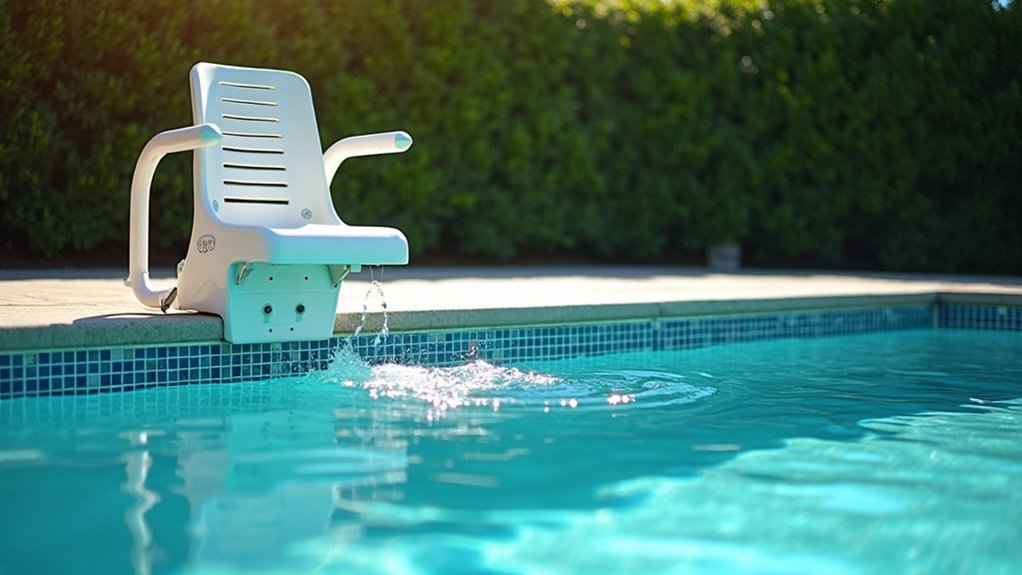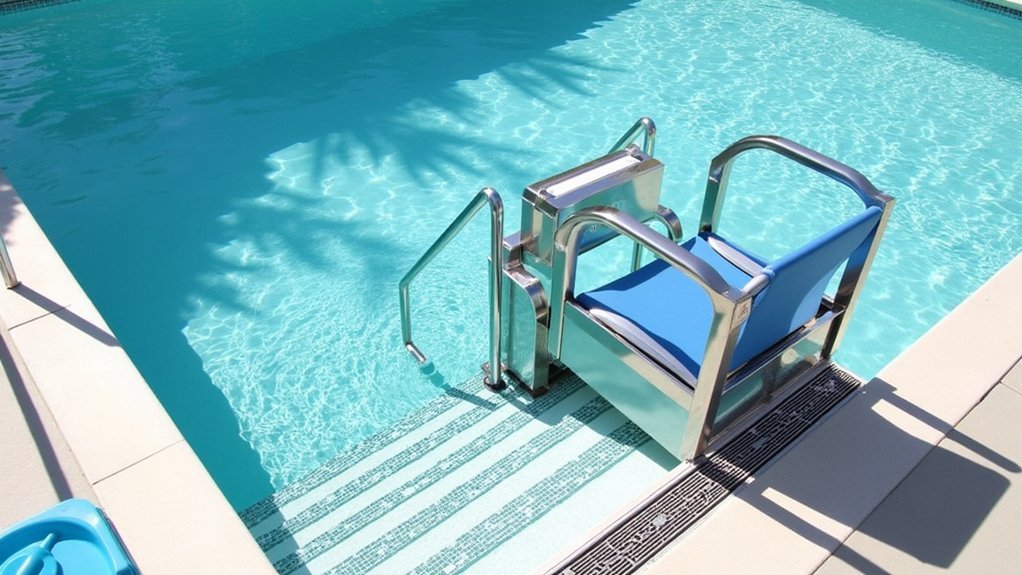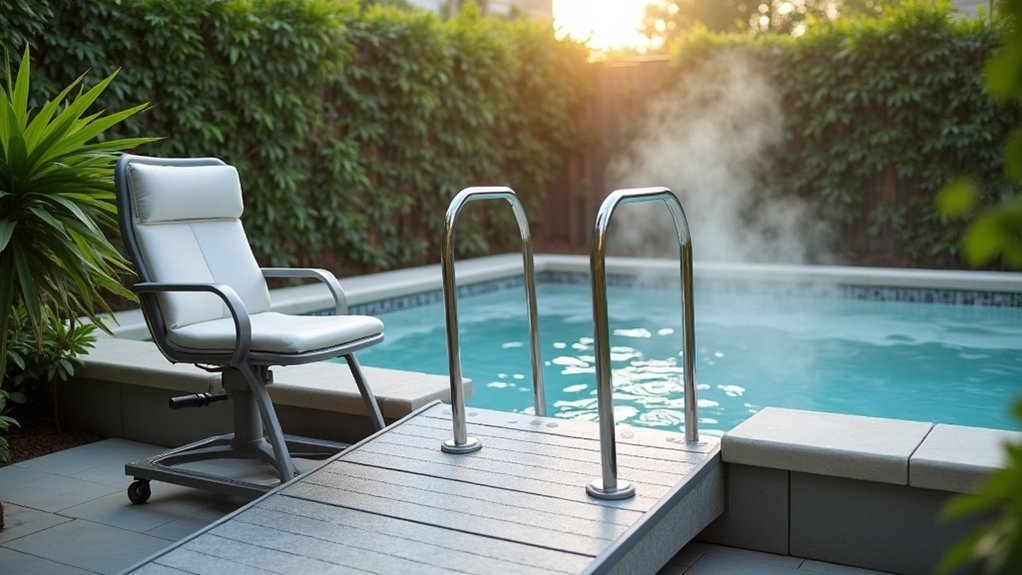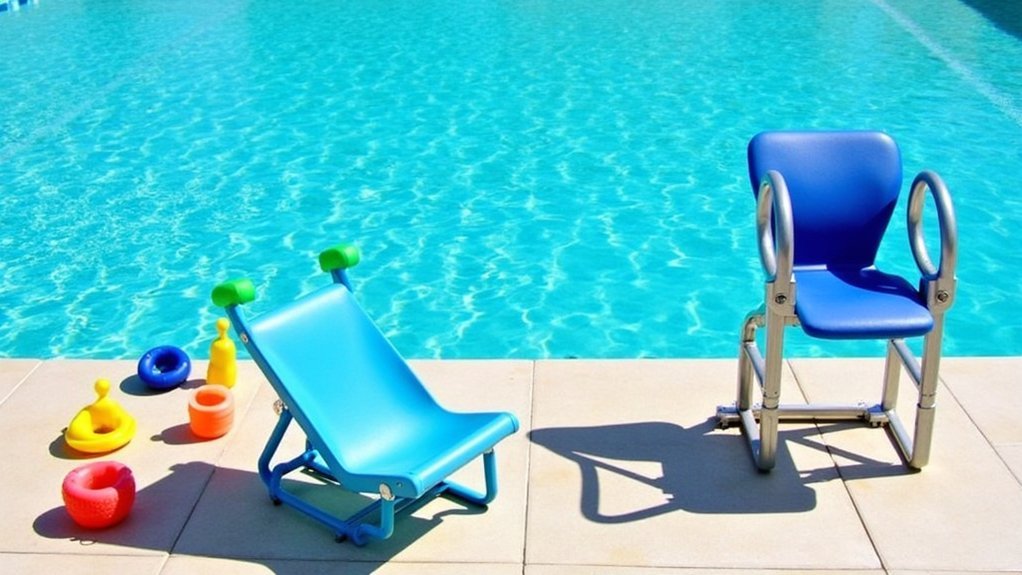Swimming pools become accessible to everyone with specialized equipment like pool lifts, sloped entries, and transfer systems. You’ll find battery-powered or hydraulic lifts supporting 300-500 pounds, while ramps provide gentle access with proper handrails. Transfer systems help you move from mobility devices to water, and accessible stairs with strategically placed handrails enhance safety. For therapeutic benefits, spas and hot tubs offer additional accessibility features that can transform your aquatic experience.
Pool Lifts: The Gateway to Independent Aquatic Access

While swimming offers countless benefits to people of all abilities, accessing the water can present significant challenges for individuals with mobility limitations. Pool lifts serve as the essential solution, enabling independent entry and exit from swimming pools with dignity.
These devices come in various forms—battery-powered, water-powered, or manual hydraulic—with weight capacities typically ranging from 300 to 500 pounds.
You’ll find user-friendly features including non-slip seats with safety straps, 360-degree rotation capabilities, and waterproof controls accessible from both deck and water sides. Regular maintenance and inspections help ensure these accessibility features remain safe and operational for all users.
Pool lifts aren’t just about compliance with ADA standards; they’re about creating inclusive environments where everyone can enjoy recreational and therapeutic benefits of water activities.
Whether in public pools, rehabilitation centers, hotels, or private homes, these lifts transform swimming into a truly accessible activity.
Sloped Entries and Ramps: Gradual Pathways Into Water Therapy
Sloped entries and ramps provide essential accessibility options that complement pool lifts, offering a more gradual and independent approach to water entry.
These pathways must maintain a maximum slope of 1:12 (8.33%) and extend to depths between 24-30 inches below water level.
Accessible pool ramps require a 1:12 maximum slope extending to 24-30 inches underwater for safe, independent water entry.
You’ll find handrails on both sides of every compliant slope, positioned 33-38 inches apart with a gripping surface height of 34-38 inches.
For slopes exceeding 1:20, landings at both ends are mandatory.
When using these entries, you’ll likely transfer to an aquatic wheelchair since personal mobility devices can’t be submerged.
The designed depth allows buoyancy that supports easier movement in the water.
Facilities should provide proper storage for your personal mobility device and maintain regular safety inspections of all accessibility equipment. All sloped entries must have a minimum width of 36 inches to accommodate wheelchair access while meeting ADAAG accessible route provisions.
Transfer Systems: Supporting Transition From Mobility Devices to Water

Transfer systems offer another powerful accessibility solution for swimmers with mobility limitations who need a reliable pathway into the water.
These systems include both mobile and ceiling-mounted pool lifts designed with user comfort and safety in mind. With weight capacities up to 330 lbs, they’re constructed from durable stainless steel that withstands constant water exposure.
You’ll appreciate how these electromechanical lifts operate on rechargeable batteries, requiring just one attendant to help with transfers. The 360-degree rotation capability ensures users can be positioned precisely for safe entry and exit from the pool.
They’re remarkably space-efficient—easily folded or moved when not in use—while providing smooth motion during shifts. Emergency stop buttons and waterproof controls enhance safety, while various body supports like slings accommodate different needs.
Whether you choose a portable model or permanent installation, these low-maintenance systems create a dignified, independent swimming experience.
Accessible Stairs and Handrails: Safety Features for All Abilities
Accessible stairs and handrails serve as fundamental components of inclusive pool design, creating pathways that accommodate swimmers of all mobility levels.
These features must meet specific requirements, including handrails spaced 20-24 inches apart with heights between 34-38 inches above stair nosings.
For your pool’s accessibility, you’ll need stairs with uniform risers and tread widths of at least 11 inches. Open risers aren’t permitted, and handrails require extensions at the top landing but not the bottom.
You’ll appreciate how these elements provide essential support and stability while entering or exiting the water.
Unlike pool lifts, accessible stairs require less maintenance and work well with pools of all sizes.
They’re often integrated with other accessibility features and must comply with ADAAG guidelines to guarantee safety and inclusivity. The clear space between handrail and wall must be 1.5 inches if mounted on walls.
Spa and Hot Tub Accessibility Solutions for Therapeutic Benefits

While stairs and handrails address pool entry needs, properly equipped spas and hot tubs offer unique therapeutic advantages for users with mobility challenges.
With strategically placed grab bars and non-slip surfaces, you’ll maintain safety while enjoying therapeutic benefits. These features promote independence and autonomy for users with limited mobility who seek the wellness benefits of warm water therapy.
Hydrotherapy jets provide targeted relief for arthritis and muscle pain, while adjustable settings let you customize treatment for specific body areas. You can control water temperature and jet intensity to suit your therapeutic needs.
For independent access, consider installing hoists—either portable or fixed—that eliminate the need for steps.
Wide, non-slip steps with integrated handrails offer safer alternatives for entry and exit.
Remote controls and app-based interfaces allow you to adjust settings without reaching across the tub, making the experience more comfortable and accessible.
Frequently Asked Questions
Can Home Pools Qualify for Tax Deductions With Accessibility Equipment?
Yes, you can claim tax deductions for home pools with accessibility equipment if they’re medically necessary, exclusively used for therapy, and properly documented. The expenses must exceed 7.5% of your adjusted gross income to qualify.
What Is the Average Lifespan of a Commercial Pool Lift?
Commercial pool lifts typically last 5-10 years with proper maintenance. You’ll extend your lift’s lifespan by performing daily inspections, regular cleaning, proper battery care, and protecting it from harsh environmental conditions during off-seasons.
How Much Water Displacement Occurs When Installing Sloped Entries?
Water displacement when installing sloped entries varies based on their width, depth extension (24-30 inches), and angle (maximum 1:12 slope). You’ll need to calculate your specific dimensions as no standard formula exists.
Are Portable Transfer Systems as Durable as Permanent Installations?
No, portable transfer systems aren’t as durable as permanent installations. While both use quality materials, permanent lifts typically last longer due to their stable anchoring, though portable ones offer easier maintenance and repair access.
Which Accessibility Equipment Requires the Least Maintenance?
Slope entrances and handrails require the least maintenance. You’ll appreciate their durability with minimal upkeep compared to lifts or aquatic wheelchairs, which need regular cleaning or battery checks to function properly.
In Summary
You’ve seen how pool lifts, ramps, transfer systems, stairs with handrails, and accessible spa solutions can transform aquatic experiences for everyone. When you invest in these accessibility features, you’re not just complying with regulations—you’re creating opportunities for therapy, independence, and enjoyment. Don’t underestimate how these equipment choices make a profound difference in people’s lives, opening the water’s healing benefits to all abilities.





Leave a Reply